I believe the corny is basically inline between the fermenter and the spunding valve to store CO2 that can be recycled for use to add pressure back to the fermented/carbonating beer or be used to help pressure transfer from one container to the next or whatever else you would want to do with it. Essentially it would be 'free' CO2What does the addition of a corny keg do?
You are using an out of date browser. It may not display this or other websites correctly.
You should upgrade or use an alternative browser.
You should upgrade or use an alternative browser.
Closed-system pressurized fermentation technique!
- Thread starter WortMonger
- Start date

Help Support Homebrew Talk:
This site may earn a commission from merchant affiliate
links, including eBay, Amazon, and others.
I finally got my pressurized fermentation system working. I have a hefeweizen under pressure right now. Looking at the carbonation charts, I should be at 60 psi for this beer at fermentation temp. Seems high to me. Any suggestions?
Edit: Here's a picture of my set up:
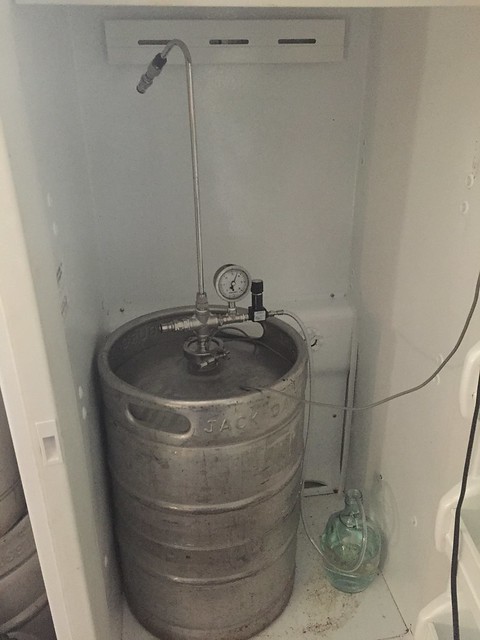
What is the purpose of the blow off tube and water jug after the spunding valve? I would not expect fermentation blowoff to make it through the spunding valve without clogging it and creating a pressure bomb. I have already gone through one of those same valves from having some sticky wort flow through it.
On another note I see that some of you using the tri clamp setup instead of the stock sanke dip tube don't have a secondary safety pressure valve. Not the safest approach IMHO. One of the advantages of going with the sanke dip tube is that all sanke couplers have a 60 psi safety relief valve built into them.
Thanks Tegra, I have it at 20 psi now.
As far as having the jug after the spunding valve, I guess I should rethink my setup. I saw the filter canister idea, so I may have to incorporate that into my setup. I have tried the sanke dip tube and coupler, but it didn't work for me. I got krausen into the spunding valve, and when I kegged the beer, I picked up a ton of yeast. I decided to go with the tri clamp setup instead. Using the tri clamp, I'm not too concerned about krausen reaching the spunding valve since I do 10 gallon batches.
But, there's always that chance.
Back to the drawing board...
As far as having the jug after the spunding valve, I guess I should rethink my setup. I saw the filter canister idea, so I may have to incorporate that into my setup. I have tried the sanke dip tube and coupler, but it didn't work for me. I got krausen into the spunding valve, and when I kegged the beer, I picked up a ton of yeast. I decided to go with the tri clamp setup instead. Using the tri clamp, I'm not too concerned about krausen reaching the spunding valve since I do 10 gallon batches.
But, there's always that chance.
Back to the drawing board...
1MadScientist
Well-Known Member
I am not following what you do. Is this a corny you have inline between the fermenter(s) and spunding valve?(I have a separate corny that I store the co2 in and then hook up during cooling, with a regulator set to about 8 psi to finish carbonating)
Tom
Pictures would help if it is something different.
MS
Mad scientist:
It was actually you that got me started on this! (With your photo of your dedicate co2 corny)
I have since been inspired by oldfart over on brewboard to try harvesting in several corny kegs in series, and the. Compressing with tap water pressure.
This gives me enough co2 to carbonate and transfer from the fermenting Sanke to my three serving kegs.
(I like to put the crazy in mad)
Tom
It was actually you that got me started on this! (With your photo of your dedicate co2 corny)
I have since been inspired by oldfart over on brewboard to try harvesting in several corny kegs in series, and the. Compressing with tap water pressure.
This gives me enough co2 to carbonate and transfer from the fermenting Sanke to my three serving kegs.
(I like to put the crazy in mad)
Tom
This was all developed by "Oldfart" over at brewboard.com over 10 years ago.
They thought him mad for even thinking about doing this. It seems he soon after disappeared, so maybe he was?
(Would love to get in touch with him)
This is what I have been playing with for the last few brews....
- Sanke is in a chest freezer with the co2 pipe going through the wall.
- I have been brewing about a 12 gallon batch.
- The small keg is a 3 gallon I bottle from and reuse for the next batch
- Fermcap is necessary to prevent blowoff
Tom
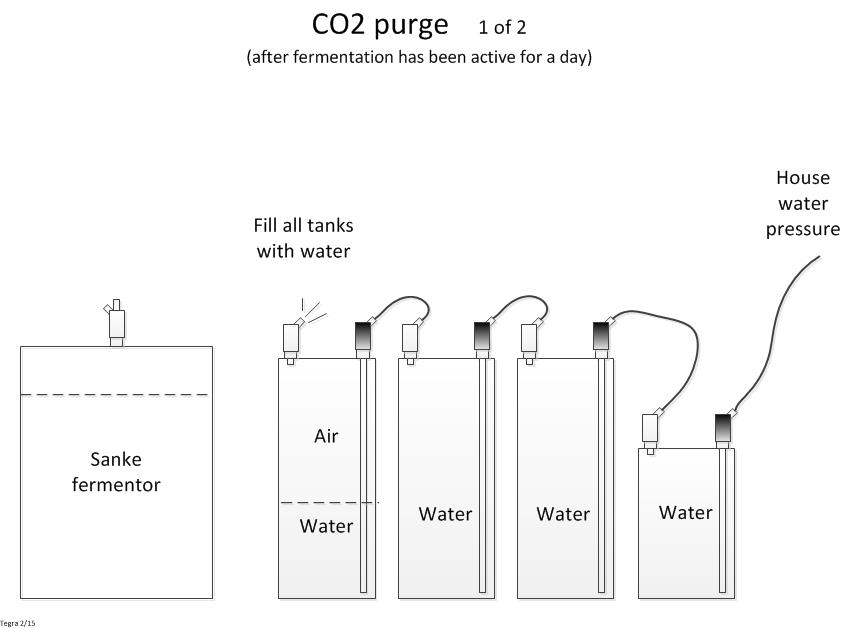
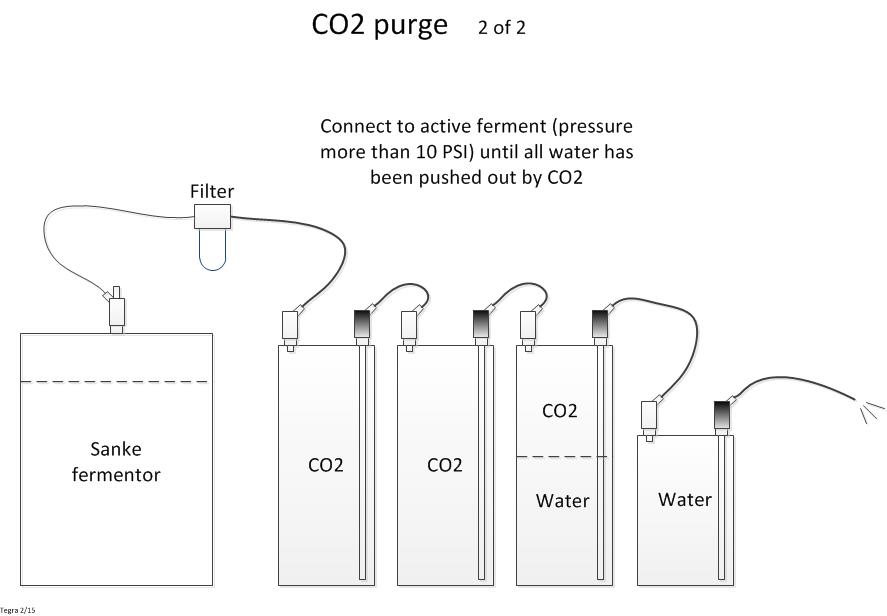
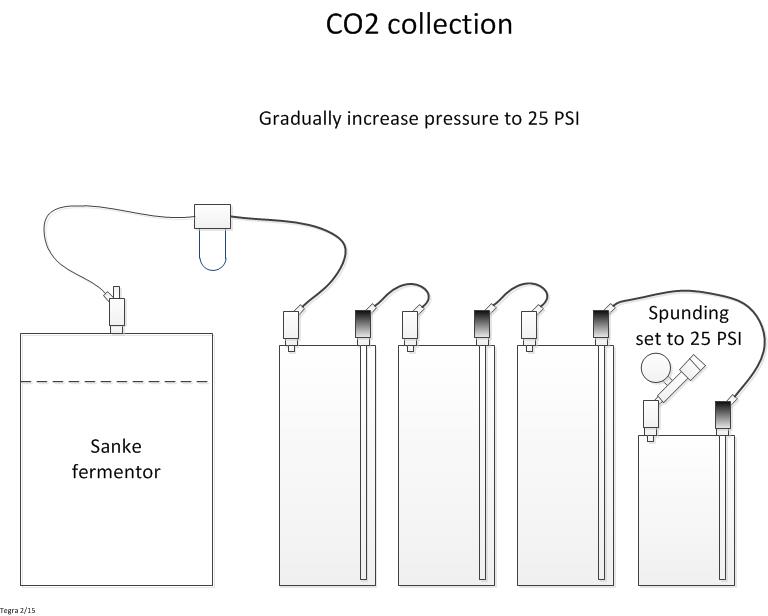
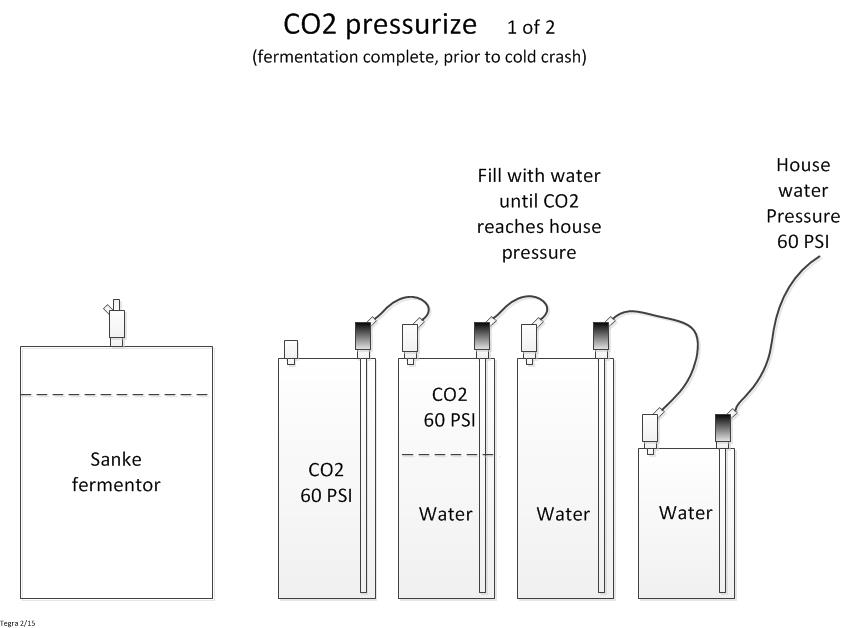
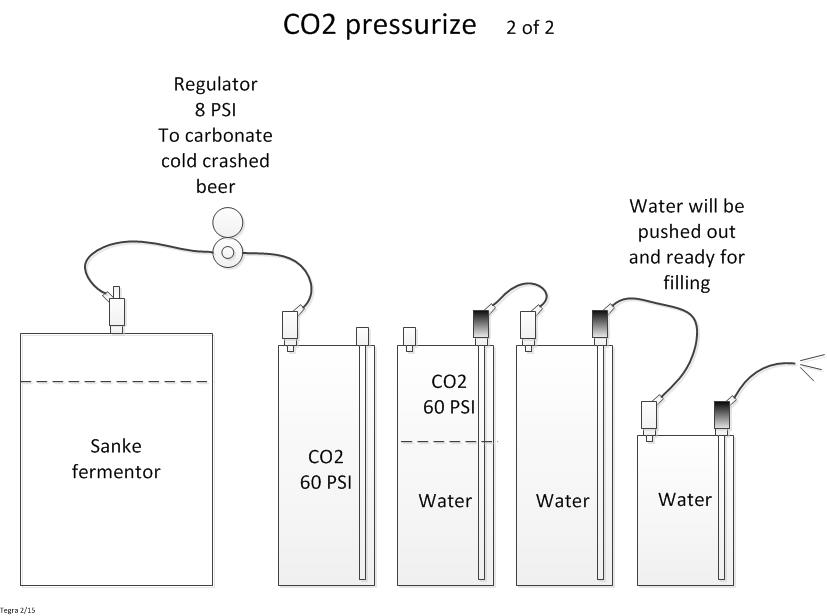
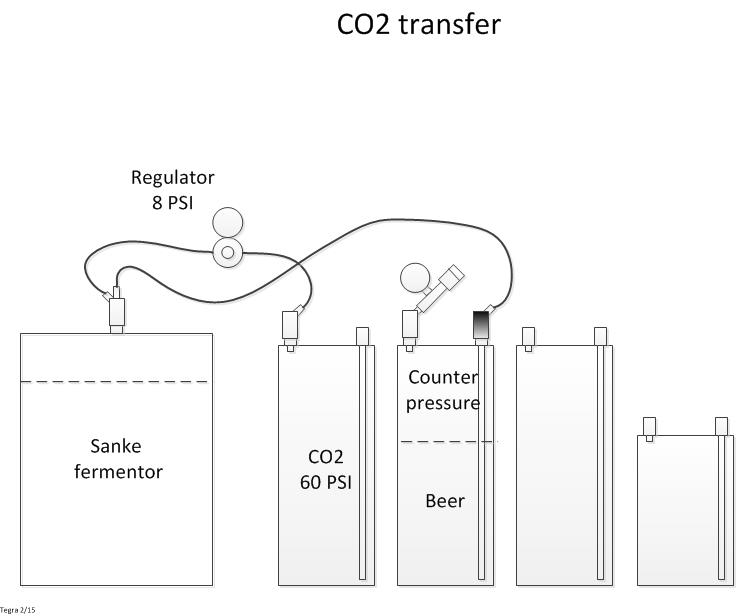
They thought him mad for even thinking about doing this. It seems he soon after disappeared, so maybe he was?
(Would love to get in touch with him)
This is what I have been playing with for the last few brews....
- Sanke is in a chest freezer with the co2 pipe going through the wall.
- I have been brewing about a 12 gallon batch.
- The small keg is a 3 gallon I bottle from and reuse for the next batch
- Fermcap is necessary to prevent blowoff
Tom







$58.16
HUIZHUGS Brewing Equipment Keg Ball Lock Faucet 30cm Reinforced Silicone Hose Secondary Fermentation Homebrew Kegging Brewing Equipment
xiangshuizhenzhanglingfengshop

$53.24
1pc Hose Barb/MFL 1.5" Tri Clamp to Ball Lock Post Liquid Gas Homebrew Kegging Fermentation Parts Brewer Hardware SUS304(Liquid Hose Barb)
Guangshui Weilu You Trading Co., Ltd

$479.00
$559.00
EdgeStar KC1000SS Craft Brew Kegerator for 1/6 Barrel and Cornelius Kegs
Amazon.com

$53.24
1pc Hose Barb/MFL 1.5" Tri Clamp to Ball Lock Post Liquid Gas Homebrew Kegging Fermentation Parts Brewer Hardware SUS304(Liquid MFL)
yunchengshiyanhuqucuichendianzishangwuyouxiangongsi

$20.94
$29.99
The Brew Your Own Big Book of Clone Recipes: Featuring 300 Homebrew Recipes from Your Favorite Breweries
Amazon.com

$22.00 ($623.23 / Ounce)
AMZLMPKNTW Ball Lock Sample Faucet 30cm Reinforced Silicone Hose Secondary Fermentation Homebrew Kegging joyful
无为中南商贸有限公司

$176.97
1pc Commercial Keg Manifold 2" Tri Clamp,Ball Lock Tapping Head,Pressure Gauge/Adjustable PRV for Kegging,Fermentation Control
hanhanbaihuoxiaoshoudian

$33.99 ($17.00 / Count)
$41.99 ($21.00 / Count)
2 Pack 1 Gallon Large Fermentation Jars with 3 Airlocks and 2 SCREW Lids(100% Airtight Heavy Duty Lid w Silicone) - Wide Mouth Glass Jars w Scale Mark - Pickle Jars for Sauerkraut, Sourdough Starter
Qianfenie Direct
I could use some help with a simple question about this process. I went through the first 200 posts and cannot find a clear answer. I'm using 5 gal. corny kegs, ten gallon batches and plan to put the wort into three kegs.
I will put a spunding valve on the gas-in post. Leave it furment under pressure and here is where I get confused.
My current batches produce a fair amount of trub. I can't see how I can take a sample or transfer the beer through the small out post without completely clogging it. Or is that even an issue? I've seen comments that you have to draw off a couple pints to get to clear beer, but I haven't seen anyone say anything about problems getting the beer out. Does the trub actually just flow through the small out post?
I also see some are cutting their dip tubes shorter to avoid the trub, but then others say this isn't necessary.
Apologies if this has been covered, but if you can, what's the scoop?
I will put a spunding valve on the gas-in post. Leave it furment under pressure and here is where I get confused.
My current batches produce a fair amount of trub. I can't see how I can take a sample or transfer the beer through the small out post without completely clogging it. Or is that even an issue? I've seen comments that you have to draw off a couple pints to get to clear beer, but I haven't seen anyone say anything about problems getting the beer out. Does the trub actually just flow through the small out post?
I also see some are cutting their dip tubes shorter to avoid the trub, but then others say this isn't necessary.
Apologies if this has been covered, but if you can, what's the scoop?
I don't use Corny's, but I'll try to answer your question...
I think you're going to have problems with what you've described. Spunding through the gas post may clog, and could over-pressure and kill your yeast.
Using the standard dip tube will clog too. Some guys use a shortened dip tube without control of how deep the dip tube is into the trub.
What may work for you is replacing the stock pressure relief valve (assuming you have one) with a specially made spunding valve, and then go with a shortened dip tube.
What I would do though, is get a second Corny lid and adapt it specially for fermenting.
Use a compression fitting with rubber o-rings like the ones that Bobby sells, and a ss racking cane that can slide up and down to control the depth of the cane, and also a NPT spud that you can screw an adjustable pressure relief valve into as a spunding valve.
I think you're going to have problems with what you've described. Spunding through the gas post may clog, and could over-pressure and kill your yeast.
Using the standard dip tube will clog too. Some guys use a shortened dip tube without control of how deep the dip tube is into the trub.
What may work for you is replacing the stock pressure relief valve (assuming you have one) with a specially made spunding valve, and then go with a shortened dip tube.
What I would do though, is get a second Corny lid and adapt it specially for fermenting.
Use a compression fitting with rubber o-rings like the ones that Bobby sells, and a ss racking cane that can slide up and down to control the depth of the cane, and also a NPT spud that you can screw an adjustable pressure relief valve into as a spunding valve.
JuanMoore
Getting the banned back together
I could use some help with a simple question about this process. I went through the first 200 posts and cannot find a clear answer. I'm using 5 gal. corny kegs, ten gallon batches and plan to put the wort into three kegs.
I will put a spunding valve on the gas-in post. Leave it furment under pressure and here is where I get confused.
My current batches produce a fair amount of trub. I can't see how I can take a sample or transfer the beer through the small out post without completely clogging it. Or is that even an issue? I've seen comments that you have to draw off a couple pints to get to clear beer, but I haven't seen anyone say anything about problems getting the beer out. Does the trub actually just flow through the small out post?
I also see some are cutting their dip tubes shorter to avoid the trub, but then others say this isn't necessary.
Apologies if this has been covered, but if you can, what's the scoop?
Only the trub right next to the bottom of the diptube will get sucked up. After the transfer you will be able to see a small area around the diptube where the yeast cake is gone, somewhere between the size of a dime and a quarter depending on the strain of yeast and how compact the yeast cake is. While I prefer using sankey's, I've done over a dozen 10 gal batches split between 2 corny kegs with full length untrimmed diptubes. Out of those I've only had a clog one time, and it was with a highly flocculant yeast that I let ferment for 2 months, and then cold crashed for 3 days.
And it's not a couple of pints of yeast, it's more like a couple ounces of yeasty stuff, and then it flows perfectly clean. I remove the QD at the far end of my transfer line and put it in an empty pint glass, connect the QD on the other end to the fermenter, turn the gas on, and then remove the QD attached to the fermenting keg as soon as it starts running clear. Usually only fills the pint glass 1/3 way. Then I screw the line back on to the QD, connect one end to the receiving keg, and the other to the fermenter which starts the transfer. The last few ounces at the bottom of the keg will also pull a lot of yeast up, but I'm usually able to pull one of the QD's off before much makes it into the serving keg.
I don't use Corny's, but I'll try to answer your question...
I think you're going to have problems with what you've described. Spunding through the gas post may clog, and could over-pressure and kill your yeast.
Using the standard dip tube will clog too. Some guys use a shortened dip tube without control of how deep the dip tube is into the trub.
Good point, but splitting 10 gal between 3 kegs should leave enough headroom to avoid clogging the spunding valve. I usually fill mine to the brim and either use fermcap, or more frequently connect the spunding valve to a blowoff vessel rather than directly to the gas post of the fermenter keg.
As for the diptube clogging during transfer, I've only experienced that once out of over two dozen kegs using full length diptubes.
I could use some help with a simple question about this process. I went through the first 200 posts and cannot find a clear answer. I'm using 5 gal. corny kegs, ten gallon batches and plan to put the wort into three kegs.
I will put a spunding valve on the gas-in post. Leave it furment under pressure and here is where I get confused.
My current batches produce a fair amount of trub. I can't see how I can take a sample or transfer the beer through the small out post without completely clogging it. Or is that even an issue? I've seen comments that you have to draw off a couple pints to get to clear beer, but I haven't seen anyone say anything about problems getting the beer out. Does the trub actually just flow through the small out post?
I also see some are cutting their dip tubes shorter to avoid the trub, but then others say this isn't necessary.
Apologies if this has been covered, but if you can, what's the scoop?
Just a thought, and I may be imagining it wrong, but you could possibly get away with removing the poppit from the post you are venting gas from (for the spunding valve), or drawing your samples from. That way you would remove that bottleneck where hop debris and trub can be problematic. Another thing that could work, would be to fill the cornies evenly(or 3.5-4 gal in 2 of them, the rest in the third), then jumper them together gas to beer posts and spund from only the gas post on one end, this way any venting co2 from either of the other kegs will push the trub away from the beer diptubes(helps prevent clogging? though the one on the far end will not get this possible benefit). It probably will take longer to all settle out of the vent side kegs though.
This is all wild ass guessing on my part so grain of salt and all of that. Feel free to tell me I am wrong and why it won't work. There is the potential that it may drive off hop aromas by bubbling all that CO2 through up to two kegs.
I have a diagram of how I used to use cornys back on 1943...
https://www.homebrewtalk.com/showpost.php?p=6101543
Moved on to a single Sanke to get my quantity up and simplify things a bit. (Also to free up the kegs)
Fermcap is essential and I did get a couple plugged liquid tubes. (Easily solved by pushing some co2 back through the post)
Tom
https://www.homebrewtalk.com/showpost.php?p=6101543
Moved on to a single Sanke to get my quantity up and simplify things a bit. (Also to free up the kegs)
Fermcap is essential and I did get a couple plugged liquid tubes. (Easily solved by pushing some co2 back through the post)
Tom
Thanks for all the tips. I'm going to assemble some parts and give it a try. Tegra's drawing is helpful. As is typcial, I'll probably come up with my own wild ass design and go from there. That's the fun of this hobby,
OnNe more question . . . what is the best way to oxegenate the wort before (or when) you put it into the fermenter. Right now I either shake the glass carboy or run small pump with a stone on the end inserted into the wort.
1MadScientist
Well-Known Member
OnNe more question . . . what is the best way to oxegenate the wort before (or when) you put it into the fermenter. Right now I either shake the glass carboy or run small pump with a stone on the end inserted into the wort.
I'm a roller
 2/16/2013 by Mad Scientist Brewhaus, on Flickr
2/16/2013 by Mad Scientist Brewhaus, on FlickrMS
OnNe more question . . . what is the best way to oxegenate the wort before (or when) you put it into the fermenter. Right now I either shake the glass carboy or run small pump with a stone on the end inserted into the wort.
The pump with stone is better than shaking a glass carboy. Read my story here.
Maybe the best way is to use pure oxygen. You can get the cheap oxygen tanks at just about any hardware store.
Maybe the best way is to use pure oxygen. You can get the cheap oxygen tanks at just about any hardware store.
That is what I use. I have a stone mounted to a tee on the output of my plate chiller. So I chill, oxygenate, and fill my fermentor at the same time.
I'm about to give this method a try.
The plan is to use a 2nd corney to make up for the lack of head space. (with fermcap) Should I seal everything up with co2 or let it naturally carb seal?
It depends on your kegs. All my corneys I bought used and need to be hit with at least 15psi while I pull up on the lid handle to get them to settle into position where they will seal. If I just close the lid and apply 10psi I will end up with a leak.
Now on the flip side, I also found that sealing the lids with 15psi and bleeding down to 5psi would maintain the seal, but all the beers I fermented in corneys didn't ferment as fast as I would normally get nor would I hit the final gravity I was expecting. I think this is because I was shocking and/or killing a bunch of the yeast with the sudden increase in pressure. I am now fermenting only in sanke kegs and am getting the fast finishing fermentations that are hitting the final gravities I'm expecting.
It depends on your kegs. All my corneys I bought used and need to be hit with at least 15psi while I pull up on the lid handle to get them to settle into position where they will seal. If I just close the lid and apply 10psi I will end up with a leak.
Ever try keg lube? I slap some of that on and close the lid, then pump CO2 in. Never have a leak.
Ever try keg lube? I slap some of that on and close the lid, then pump CO2 in. Never have a leak.
Yes. I have to use it every time. My kegs seem to be in much worse shape than others I've seen.
Mad scientist:
I see photos showing you using a oxygen pumping station set up on a stool. Have you abandoned that?
(I use a recirculating pump on the Sanke and inject the oxygen into a tee and run for 5 minutes. Then unplug the oxygen tank and "suck" in the yeast and fermcap)
Tom
I see photos showing you using a oxygen pumping station set up on a stool. Have you abandoned that?
(I use a recirculating pump on the Sanke and inject the oxygen into a tee and run for 5 minutes. Then unplug the oxygen tank and "suck" in the yeast and fermcap)
Tom
chapusin
Well-Known Member
I gotta say since I stopped using pressure fermentation my beers don't show the quality I expect anymore. It was awesome fermenting at 10 psi and having the beer almost ready to drink at 2 weeks. Now with the plastic fermenters I bought (55 gallon), beer comes out flat and estery.
Trying a Bavarian Hefe fermenting at 12 psi. First proper pressure ferment. Not sure how pressure will affect ester production so I'm letting temp free rise. It's just over 75. :-/
View attachment ImageUploadedByHome Brew1429384515.279782.jpg
View attachment ImageUploadedByHome Brew1429384515.279782.jpg
BrewdogSC
Active Member

Got my parts in today, pressure testing, checking pressure changes per turn of knob. Big thanks to Wortmonger, 1MadScientist, Tegra, Poindexter, Kaiser, and everyone else that has contributed to this thread. I heard about spunding valves from a Home Brewing friend of mine in Germany and did a search and found this great thread. I can't wait to try this out this weekend! Thanks again everyone for taking the time to make your posts!
One thing I might add...
It may help to take frequent tests from the liquid port during the ferment and the cold crash/clearing stage. When I first started I did this out of curiosity but then stopped. I then got plugging dip tube.
I was playing around with a trub trap (same as the cap on the end of a siphon tube) and found I needed to put some spacer in the bottom of the cap to keep it from getting stuck to the bottom of the dip tube. Not sure if it is worth the effort as it may waste more beer than just discarding the first bit.
(Actually on my last sanke ferment I did not test at all and the first opening of the tap was full of congealed yeast. Barely got it cleared. Next time it will be sure to do at least one clearing before crashing)
Tom
It may help to take frequent tests from the liquid port during the ferment and the cold crash/clearing stage. When I first started I did this out of curiosity but then stopped. I then got plugging dip tube.
I was playing around with a trub trap (same as the cap on the end of a siphon tube) and found I needed to put some spacer in the bottom of the cap to keep it from getting stuck to the bottom of the dip tube. Not sure if it is worth the effort as it may waste more beer than just discarding the first bit.
(Actually on my last sanke ferment I did not test at all and the first opening of the tap was full of congealed yeast. Barely got it cleared. Next time it will be sure to do at least one clearing before crashing)
Tom
BrewdogSC
Active Member
Thanks Tom, I will keep that in mind. I was going to try the idea you had in your sketches with the copper cap, but hadn't thought about adding some type of spacer, I'll leave them off. Thanks for taking the time to post your experiences.
Today is brew day here, I will add my experiences as the fermentation unfolds.
Today is brew day here, I will add my experiences as the fermentation unfolds.
BrewdogSC
Active Member
View attachment ImageUploadedByHome Brew1430091004.299253.jpg
Here is the set up in action. At 3 psi
Ambient temp is 65 F
On keg at 65. OG 1.046
Other 68 still cooling 1.048
Both pitched with US-05
Here is the set up in action. At 3 psi
Ambient temp is 65 F
On keg at 65. OG 1.046
Other 68 still cooling 1.048
Both pitched with US-05
Anyone have advice for adding a thermowell to a corny? I drilled a hole in the lid and put in a grommet. Dropped the thermowell through that. It leaks very slowly. Will hold pressure for a few days, but not much longer. Is there a better way?
Anyone have advice for adding a thermowell to a corny? I drilled a hole in the lid and put in a grommet. Dropped the thermowell through that. It leaks very slowly. Will hold pressure for a few days, but not much longer. Is there a better way?
seal the grommet to it with a little food safe silicone, maybe the same between the thermowell and grommet too?
Similar threads
- Replies
- 25
- Views
- 894
- Replies
- 2
- Views
- 455
- Replies
- 2
- Views
- 361





























